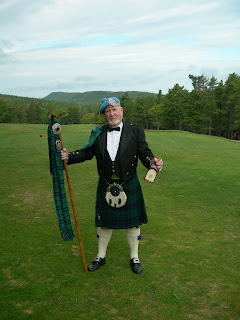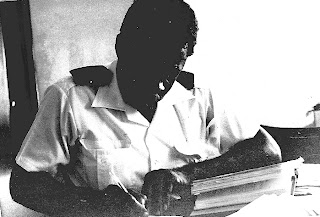
(The M/T MacVie, fully loaded, sails under the high bridge (Queen Juliana Bridge) on her way to Bonaire.)
(For a larger view of any picture, double click on the thumbnail photo.)
The is the last part of the MacVie narrative which was covered in ten parts from finding her to getting chartered. Starting with the next post, I want to share some vignettes featuring both humorous and serious events over the two years we ran the charter. For example, the murder of our crewman, Ethan Toney.
This part of the narrative, has a question mark behind "Victory???" because there was trouble yet to come, the outcome of which we were uncertain in November, 1981.
In mid November, 1981, the Shell Refinery Marketing Department agreed to hire the M/T MacVie to run the Bonaire as needed, which turned out to be about once a week. By Mid December, however, I began to realize that the $900 per day rate was inadequate to retire our loan and repairs. It was the 1980s and interest rates were soaring. Our loan was with Heller & Company of Chicago at an interest rate of 24.3%. Something had to be done or we would surely fail. But what?
While we ran the trips to Bonaire as planned, I kept pondering what could be done to get them to increase our charter. My chance came on January 8, 1982, when Shell handed me the completed Time Charter document supposedly containing all the terms which had been negotiated. In the approximately two months since we started sailing. I had learned something about shipping and charters and that was to read and study your charter carefully and thoroughly and hold your charterer to the provisions in them because they will hold those same provisions against you. When I got the actual charter, I did just that and discovered that all the restrictions that were agreed to regarding where and how they could use the MacVie were ignored. Whether this was by design or mistake it mattered not; I took the charter at face value and decided to take action.
After a day or so, I wrote an extensive letter to Mr. Schoonbrood of Shell in which I pointed out the lack of restrictions. I concluded the letter by saying that as far as our company was concerned, the charter was null and void and had to be re-negotiated. Period. I delivered the letter by hand and the next morning I was called to Schoonbrood's office for a discussion.
As forcefully as I could, I pointed out the provisions in the charter which dealt with voiding the charter. He listened intently but said nothing. After a few moments of silence I said that he knew the charter and shipping business better than I and that he knew that the rate negotiated was inadequate. Further, I pointed out again that neither he nor I were part of the negotiation so we had no emotional ties to the terms. Then I asked for $300 more per day for a total of $1,200. Though reserved, he was friendly and said he would take it to his board to get their response.

 (Here we are underway heading for Bonaire. With the deck almost at the waterline, the seas wash over it as though it was a immovable dock. Sailing back and forth was always a pleasant experience. Porpoises and flying fish were regular visitors and once a baby surfaced near the ship.)
(Here we are underway heading for Bonaire. With the deck almost at the waterline, the seas wash over it as though it was a immovable dock. Sailing back and forth was always a pleasant experience. Porpoises and flying fish were regular visitors and once a baby surfaced near the ship.)Within a few days, Schoonbrood called to tell me that he would like to see me. Dressed in a suit and tie as most Dutch businessmen, I arrived full of anticipation tinged with dread. What would I do if he said "no?"
I had brought a briefcase with me and I opened it and spread out my papers on the table. He got right to the point: his board understood the situation and agreed that 1) the rate was too low, 2) that they would raise it to $1,200 as requested effective immediately, and 3) all the restrictions previously negotiated would be spelled out. I thanked him and but said I wanted the pay to be retroactive to when we started sailing, almost 60 days earlier, a total of $18,000.
Absolutely not, he said.
Now this is one of those decisive moments when a businessman has to take the ultimate risk: all, compromise, or nothing. I chose "all" because in reality I had no other option.
I slowly picked up my papers, swept them into my briefcase, snapped it shut, and said, "Well, Mr. Schoonbrood, I 'm afraid I will have to pick up my chips and go home," and with that I got up, shook his hand, and walked across the office toward the door. As I walked, I started to panic. Was this foolish? What the Hell was I doing? One is amazed how many thoughts can go through one's head as he is making this dramatic a move.
When I got to the door, in an irritated voice, he said, "Come back here!"
 (One of the local pilots which we were required to use when entering the Ports of Bonaire and Curacao. Pilots have specialized knowledge of local conditions.)
(One of the local pilots which we were required to use when entering the Ports of Bonaire and Curacao. Pilots have specialized knowledge of local conditions.) 
(Berthed at Bonaire's desalinization plant where sea water is converted to fresh water. The equipment needed a weekly ration of gas oil. We stayed at this location only as long as it took to off-load the oil after which we would be taken by pilot to the main pier in Kralendijk, the largest city in Bonaire and the seat of the local government.
 (Approaching our berth in downtown Kralendijk, the main city in Bonaire. From this pier we off-loaded gasoline and propane tanks. Typically, we would remain in Bonaire for a couple of days just relaxing before heading back to the refinery.)
(Approaching our berth in downtown Kralendijk, the main city in Bonaire. From this pier we off-loaded gasoline and propane tanks. Typically, we would remain in Bonaire for a couple of days just relaxing before heading back to the refinery.) (At our berth in the center of Kralendijk. The vessel to the far right is the bow of the condemned tanker "Debbie" which we replaced.)
(At our berth in the center of Kralendijk. The vessel to the far right is the bow of the condemned tanker "Debbie" which we replaced.)Relieved, I went back to the table and opened my briefcase resolving as I did that I might have to accept defeat or compromise after all. But it was neither: he agreed to the retroactive pay and ordered his secretary to cut a check. Less friendly now, he handed me the check and said simply, "Good luck." I thanked him and mumbled something about having a good working relationship , etc. and then departed as quickly as possible.
I drove immediately to the Bank of America where I had my account. Standing on the front steps of the bank, I turned and with arms and check raised like Rocky Balboa, I had my son-in-law, Jack Eberhard, take my picture. Unfortunately, we can't find it for this blog.
So everything was signed, sealed and delivered and we were in business. Little did I know, however, that at the time I had planted the seeds for my eventual downfall. But thats another chapter for later. In the meantime, let's bask with a few vignettes.

(The M/T Macvie returning empty from Bonaire.)
Next: A portrait of the wonderfully vexing Captain Christopher "Zack" Zahariasyzwitz.









































